 National Environmental Management Act, 1998 (107 of 1998)
National Environmental Management Act, 1998 (107 of 1998)
R 385
Electronic Communications Act, 2005 (Act No. 36 of 2005)ICASANotice regarding Final Radio Frequency Assignment Plans for the Frequency Band 410 to 430 MHz in terms of Regulation 3 of the Radio Frequency Spectrum Regulations, 20155. Requirements for usage of radio frequency spectrum |
| 5.1 | This section covers the minimum key characteristics considered necessary to make the best use of the available frequencies. |
| 5.2 | The use of the band is limited to potential emerging applications such as broadband PPDR and IoT, in addition to digital public trunking services. |
| 5.3 | In some cases, a radio system conforming to the requirements of this RFSAP may require modifications if harmful interference is caused to other radio stations or systems. |
| 5.4 | The allocation of spectrum and shared services within these bands are found in the NRFP. An extract of the NRFP is shown in Appendix A. |
| 5.5 | The technical conditions listed in Sections 35.6 - 35.8 shall be applied as an essential component necessary to ensure coexistence between neighbouring networks. Operators may agree, on a bilateral or multilateral basis, different technical parameters providing that they continue to comply with the technical conditions applicable for the protection of other services, applications, or networks and with their cross-border obligations. |
| 5.6 | Non-3GPP Land mobile systems with channel bandwidths of 6.25 kHz, 12.5 kHz and 25 kHz, 50 kHz, 100 kHz, 150 kHz, and 200 kHz |
| 5.7 | The land mobile systems with channel bandwidths of 6.25 kHz, 12.5 kHz and 25 kHz, 50 kHz, 100 kHz, 150 kHz, and 200 kHz (the same requirements apply for channel bandwidth between 6.25 kHz and 200 kHz) should comply with requirements listed in ECC/DEC/ (19)0224 |
| 5.8 | Transmitter Masks, Unwanted Emissions and Receiver Requirements for land mobile systems with channel bandwidth of 1.25 MHz, 1.4 MHz, 3 MHz, and 5 MHz |
ECC/DEC/ (19)0225, supported by ECC Report 28326, advises on the technical requirements for land mobile systems with channel bandwidth of 1.25 MHz, 1.4 MHz, 3 MHz, and 5 MHz (for 410 – 430 MHz):
| 5.8.1 | Transmitter Masks |
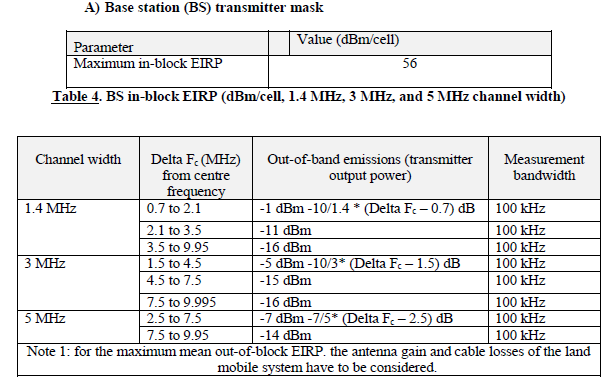
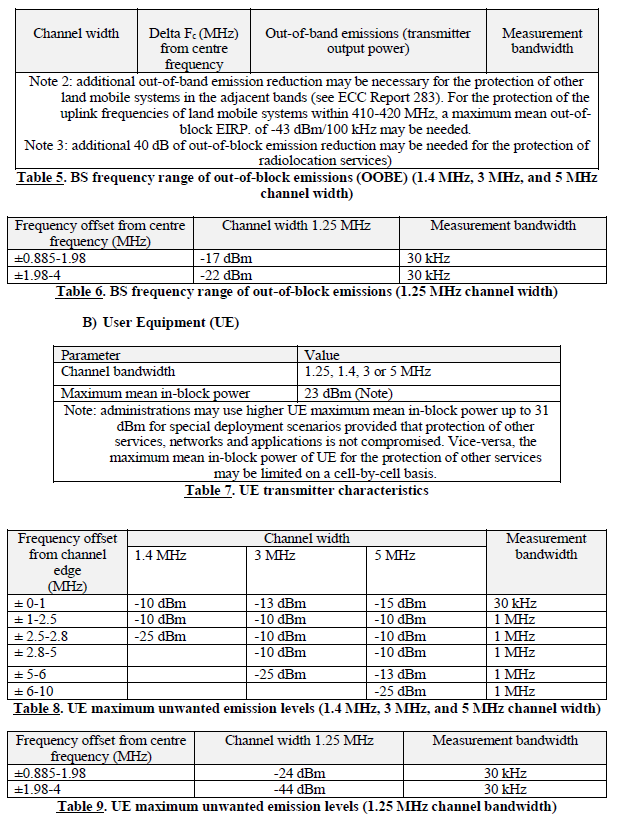
| 5.8.2 | Unwanted Emissions |
| 5.8.2.1 | Unwanted emissions in the spurious Domain |
The unwanted emissions within the spurious domain during operation shall not exceed -36 dBm for frequencies up to 1 GHz and shall not exceed -30 dBm for frequencies above 1 GHz. In standby mode, the unwanted emissions shall not exceed -57 dBm for frequencies up to 1 GHz and shall not exceed - 47 dBm for frequencies above 1 GHz.
| 5.8.2.2 | Intermodulation Attenuation |
This requirement applies only to transmitters to be used in base stations or repeaters.
Intermodulation attenuation is a measure of the capability of a transmitter to inhibit the generation of signals in its non-linear elements caused by the presence of the transmitter power and an interfering signal entering the transmitter via its antenna.
In general, the intermodulation attenuation ratio shall be at least 40 dB for any intermodulation component.
Note that national administrations may require a more stringent intermodulation attenuation requirement for base station equipment to be used in special service conditions, e.g., at sites where more than one transmitter will be in service, this is recommended to be at least 70 dB for any intermodulation component.
| 5.8.2.3 | Adjacent channel transient power |
Transient power is the power falling into adjacent spectrum due to switching the transmitter on and off. The transient power in the adjacent channels (e.g., caused by push-to-talk functionality) shall not exceed -60 dBc in the adjacent channels, or -50 dBc for equipment, without the need to be below -36 dBm.
| 5.8.3 | Receiver requirements |
The baseline performance for receiver blocking for 1.25 MHz systems is:
| a) | BS: -43 dBm at 900 kHz offset from the centre frequency; |
| b) | UE: -44.5 dBm at 900 kHz offset from the centre frequency. |
The baseline performance for receiver selectivity and blocking performance for 1.4 MHz, 3 MHz, and 5 MHz systems applicable for the 410-430 MHz is identical to those specification set out in ETSI TS 136 104 for the BS and ETSI TS 136 101 for UE for the 3GPP band 31 and 72.
| 5.9 | NB-IoT and LPWAN: Technical conditions for land mobile systems based on NB-IoT and LPWAN technologies |
Annex 4 of ECC/DEC/ (19)0227, supported by ECC Report 283 28, provides a description and technical conditions for land mobile systems based on NB-IoT and LPWAN technologies in the 410 - 430 MHz band, incl.:
| 5.9.1 | LTE NB-IoT (Inband) |
In an inband deployment, the NB-IoT technology will use some of the resources of an existing wideband carrier. This corresponds to a change of transmission mode on some subcarriers of a wideband carrier. This is very similar to what happens when a specific modulation is selected by the BS to serve a specific terminal. Embedding an NB-IoT in an LTE carrier does not change the power or the spectrum emission mask, either on the BS (base station) or the UE (user equipment) side. In particular, it is not possible to go closer to block edge than a current LTE UE could go.
| 5.9.2 | LTE NB-IoT (Guard band) |
A guard band NB-IoT deployment corresponds to the case where a narrowband transmission is added on the side of an existing wideband carrier. This is made possible by the fact that wideband transmission technologies typically transmit a signal narrower than the channel bandwidth, i.e., they implement implicit guard bands within their transmission channel. The IoT can leverage these implicit guard bands as operating spectrum. The limits in the Tables in section 35.8.3 apply for operation of a NB-IoT carrier adjacent to the BS radio frequency bandwidth edge.
| 5.9.3 | LTE NB-IoT (Standalone) |
In a standalone deployment, the IoT carrier is deployed independently, in its own narrow band spectrum. This is exactly the same deployment mode as GSM.
ECC/DEC/ (19)02 advises on the UE maximum EIRP, out-of-band emissions and other parameters, provided below.
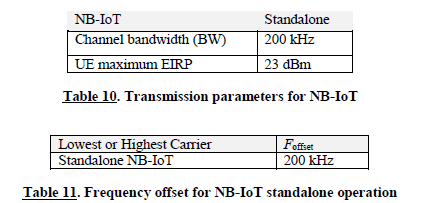
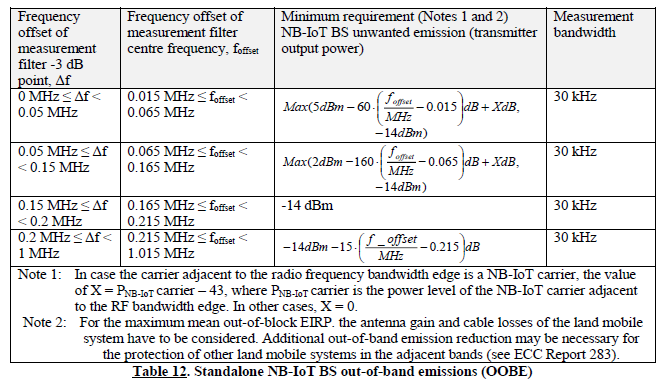
Band 31 and Band 72 have been specified in ETSI TS 136 104 and ETSI TS 136 101 also for use with NB-IoT carriers. The same technical baseline as well as receiver parameters can be assumed for operations inside the 410-430 MHz band.
ECC Report 283 assumed for the in-band BS emissions a maximum of 54 dBm/200 kHz EIRP.
| 5.9.4 | LPWAN |
ECC/DEC/ (19)0229 advises on the UE and BS maximum EIRP, out-of-band emissions and other parameters, provided below.
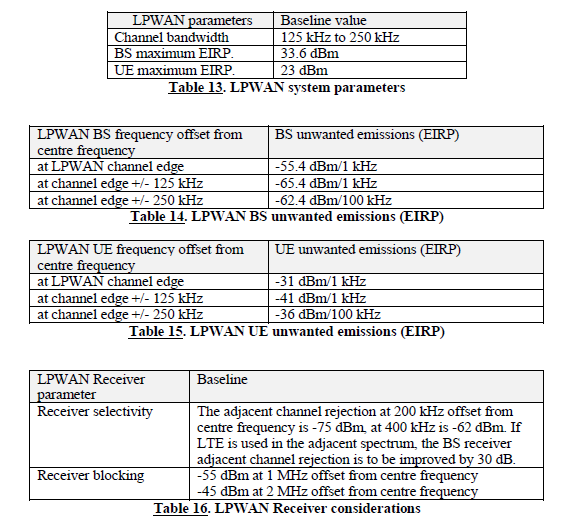
Note: the precise parameters may depend on the spreading factor used in an LPWAN system.
| 5.9.5 | Common technical conditions on Unwanted Emissions for land mobile systems based on NB-IoT and LPWAN technologies |
| 5.9.5.1 | Unwanted emissions in the spurious |
Domain The unwanted emissions within the spurious domain during operation shall not exceed -36 dBm for frequencies up to 1 GHz and shall not exceed -30 dBm for frequencies above 1 GHz. In standby mode, the unwanted emissions shall not exceed -57 dBm for frequencies up to 1 GHz and shall not exceed - 47 dBm for frequencies above 1 GHz.
| 5.9.5.2 | Intermodulation Attenuation |
This requirement applies only to transmitters to be used in base stations or repeaters. Intermodulation attenuation is a measure of the capability of a transmitter to inhibit the generation of signals in its non-linear elements caused by the presence of the transmitter power and an interfering signal entering the transmitter via its antenna.
In general, the intermodulation attenuation ratio shall be at least 40 dB for any intermodulation component.
Note that national administrations may require a more stringent intermodulation attenuation requirement for base station equipment to be used in special service conditions, e.g., at sites where more than one transmitter will be in service, this is recommended to be at least 70 dB for any intermodulation component.
| 5.9.5.3 | Adjacent channel transient power |
Transient power is the power falling into adjacent spectrum due to switching the transmitter on and off. The transient power in the adjacent channels shall not exceed -60 dBc in the adjacent channels, or -50 dBc for equipment, without the need to be below -36 dBm.
| 5.10 | BB-PPDR |
Least restrictive technical conditions (LRTC) for BB-PPDR in the paired frequency arrangement 410-420 MHZ / 420-430 MHZ, based on ECC/DEC/ (16)0230, are shown in the tables in BB-PPDR user equipment and base station sections, respectively.
| 5.10.1 | BB-PPDR User Equipment (UE) |
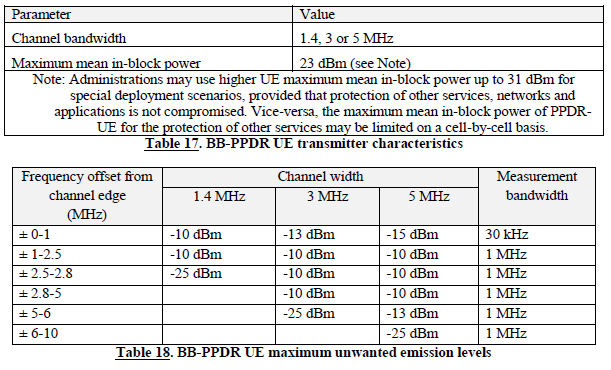
| 5.10.2 | BB-PPDR Base Station (BS) |
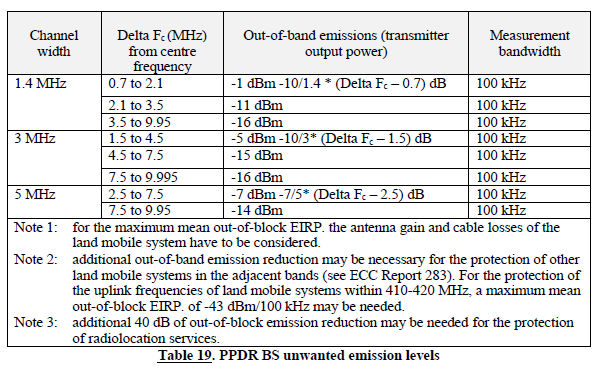
| 5.11 | Space research |
| 5.11.1 | As per ITU Radio Regulations footnote 5.268, “Use of the frequency band 410 – 420 MHz by the space research service is limited to space-to-space communication links with an orbiting, manned space vehicle. The power flux-density at the surface of the Earth produced by emissions from transmitting stations of the space research service (space-to-space) in the frequency band 410 – 420 MHz shall not exceed −153 dB(W/m2 ) for 0° ≤ δ ≤ 5°, −153 + 0.077 (d − 5) dB(W/m2) for 5° ≤ δ ≤ 70° and −148 dB(W/m2) for 70° ≤ δ ≤ 90°, where δ is the angle of arrival of the radio-frequency wave and the reference bandwidth is 4 kHz. In this frequency band, stations of the space research service (space-to-space) shall not claim protection from, nor constrain the use and development of, stations of the fixed and mobile services. No. 4.10 does not apply. (WRC-15)31” |
| 5.12 | On a case-by-case basis, higher EIRP may be permitted if acceptable technical justification is provided; |
| 5.13 | ICNIRP Guideline compliance is required, where applicable; and 5.14 Criteria and guidelines for interference mitigation are described in Appendix D. |
| 5.14 | Criteria and guidelines for interference mitigation are described in Appendix D. |
| 5.15 | The mobile network operators are encouraged to share the spectrum, e.g., using the Dynamic Spectrum Sharing (DSS) technologies available in LTE and 5G/NR. |
__________________________________________
| 24 | ECC/DEC/ (19)02, ECC Decision of 8 March 2019 on Land mobile systems in the frequency ranges 68-87.5 MHz, 146- 174 MHz, 406.1-410 MHz, 410-430 MHz, 440-450 MHz, and 450-470 MHz, 8 March 2019. (https://docdb.cept.org/document/9680) |
| 25 | ECC/DEC/ (19)02, ECC Decision of 8 March 2019 on Land mobile systems in the frequency ranges 68-87.5 MHz, 146- 174 MHz, 406.1-410 MHz, 410-430 MHz, 440-450 MHz, and 450-470 MHz, 8 March 2019. (https://docdb.cept.org/document/9680) |
| 26 | ECC Report 283, Compatibility and sharing studies related to the introduction of broadband and narrowband systems in the bands 410-430 MHz and 450-470 MHz, 14 September 2018. (https://docdb.cept.org/document/6033) |
| 27 | ECC/DEC/ (19)02, ECC Decision of 8 March 2019 on Land mobile systems in the frequency ranges 68-87.5 MHz, 146- 174 MHz, 406.1-410 MHz, 410-430 MHz, 440-450 MHz, and 450-470 MHz, 8 March 2019. (https://docdb.cept.org/document/9680) |
| 28 | ECC Report 283, Compatibility and sharing studies related to the introduction of broadband and narrowband systems in the bands 410-430 MHz and 450-470 MHz, 14 September 2018. (https://docdb.cept.org/document/6033) |
| 29 | ECC/DEC/ (19)02, ECC Decision of 8 March 2019 on Land mobile systems in the frequency ranges 68-87.5 MHz, 146- 174 MHz, 406.1-410 MHz, 410-430 MHz, 440-450 MHz, and 450-470 MHz, 8 March 2019. (https://docdb.cept.org/document/9680) |
| 30 | ECC/DEC/ (16)02, ECC Decision of 17 June 2016 on harmonised technical conditions and frequency bands for the implementation of Broadband Public Protection and Disaster Relief (BB-PPDR) systems. Amended on 8 March 2019. (https://docdb.cept.org/document/941) |
| 31 | R15-WRC15-C-2015!!MSW-E (itu.int) |